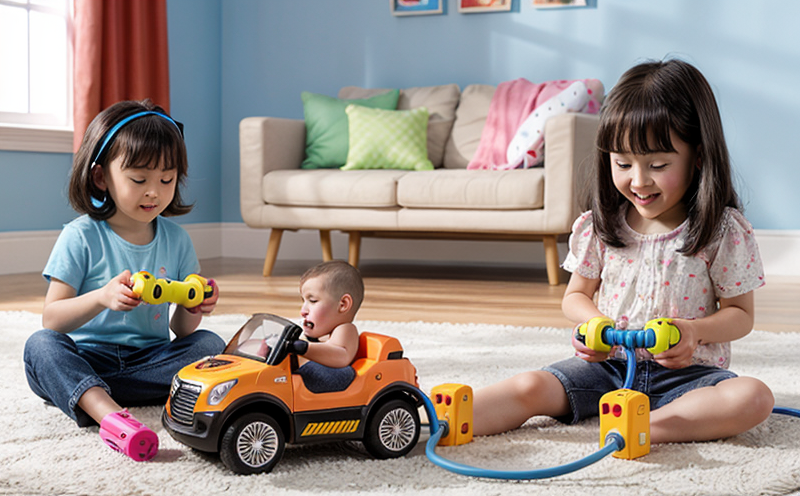EN 62115 Electrical Safety of Toys Testing
The EN 62115 standard sets out essential requirements and test methods for ensuring the electrical safety of toys, including those powered by batteries. This testing is crucial to safeguard children's health and prevent accidents associated with electrical hazards in play items.
This standard applies to all toys intended for use by children under 14 years old that incorporate electrical components or battery power sources. The scope includes various types of toys such as remote control vehicles, electronic dolls, and interactive games. Compliance ensures that the toy does not pose a risk from electrical faults which could lead to burns, shocks, or other injuries.
The testing procedure outlined in EN 62115 involves several key steps, each designed to identify potential risks associated with the toy's electrical components:
- Visual inspection for exposed live parts and insulation damage
- Measurement of insulation resistance between conductors and earth
- Testing for overcurrent protection in case of short circuits or faults
- Evaluation of the effectiveness of protective devices such as fuses, circuit breakers, and grounding systems
- Verification that toys comply with voltage limits specified in the standard
The testing process is carried out using specific apparatus designed to simulate real-world conditions. For instance, a high-impedance source simulates battery power, while an insulation resistance tester measures the electrical resistance of insulating materials.
| Test Parameter | Description |
|---|---|
| Insulation Resistance | The minimum required value varies by voltage category. For instance, for toys with a nominal voltage not exceeding 24V, the insulation resistance should be at least 1MΩ. |
| Voltage Limits | The standard specifies maximum and minimum voltage limits based on the type of toy and its intended use. |
| Overcurrent Protection | The test checks if the protective device can interrupt current within a specified time frame under fault conditions. |
In addition to these tests, EN 62115 also covers other aspects such as ensuring that the toy does not contain any small parts or components that could be harmful if swallowed. The standard emphasizes the importance of clear labeling and instructions for safe use of the toy.
Compliance with EN 62115 is essential for manufacturers to ensure their products meet legal requirements in Europe. Non-compliance can lead to product recalls, fines, and damage to brand reputation. By conducting thorough testing according to this standard, manufacturers can demonstrate due diligence and protect themselves from potential liabilities.
Our laboratory offers comprehensive services to help toy manufacturers comply with EN 62115. Our team of experts ensures that each test is conducted according to international standards, providing accurate and reliable results. We also offer guidance on how to modify product designs to meet the requirements of this standard.
Benefits
Compliance with EN 62115 offers several benefits:
- Enhanced Safety: Ensures that toys do not pose electrical hazards, protecting children from injuries.
- Legal Compliance: Helps manufacturers meet regulatory requirements in the European market.
- Brand Protection: Demonstrates a commitment to quality and safety, enhancing brand reputation.
- Risk Mitigation: Reduces the risk of product recalls and legal action.
The testing process also provides valuable insights into potential design improvements. By identifying areas where the toy could be made safer or more robust, manufacturers can enhance the overall quality of their products.
In addition to these immediate benefits, compliance with EN 62115 can contribute to long-term business sustainability by fostering trust among consumers and ensuring a favorable market position.
Environmental and Sustainability Contributions
The testing process described in EN 62115 also contributes to environmental sustainability. By identifying and addressing potential electrical hazards, the standard helps prevent accidents that could lead to waste from discarded products or medical interventions. This not only reduces healthcare costs but also promotes a safer environment for all.
In addition to safety benefits, compliance with this standard can contribute to sustainable development by encouraging manufacturers to adopt more efficient designs. For example, testing for overcurrent protection ensures that toys are designed to prevent excessive power consumption, which in turn helps reduce energy waste and carbon emissions.
The laboratory's commitment to sustainability extends beyond compliance with EN 62115. We also offer services related to other environmental standards such as ISO 14001 for environmental management systems and ISO 50001 for energy management. These services complement our electrical safety testing, providing a holistic approach to sustainable business practices.
Use Cases and Application Examples
| Toy Type | Description of Use Case |
|---|---|
| Battery Operated Remote Control Car | The toy is tested for insulation resistance, overcurrent protection, and voltage limits to ensure safe operation during play. |
| Electronic Doll with Voice Activation | Testing focuses on the protective devices used in the voice recognition circuitry to prevent electrical shocks. |
| Interactive Game with LED Lights | The toy is evaluated for insulation resistance and overcurrent protection to ensure safe operation of the lighting system during play. |
- Battery Operated Toys: These include toys such as remote control cars, electronic dolls, and interactive games. The testing process ensures that the batteries are properly protected against short circuits and overcurrents.
- Digital Toys with Voice Activation: These toys incorporate advanced electronics for voice recognition and speech synthesis. The testing focuses on ensuring that these components do not pose electrical hazards.
- LED Lighted Toys: Toys such as talking teddy bears or nightlights are tested to ensure that the LED lighting systems operate safely within specified voltage limits.
The laboratory's experts can provide detailed case studies for each type of toy, highlighting specific test parameters and specimen preparation methods used in the testing process. This information is invaluable for quality managers and R&D engineers looking to enhance product safety and compliance.





